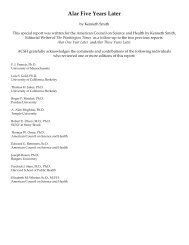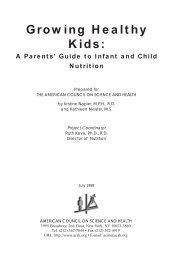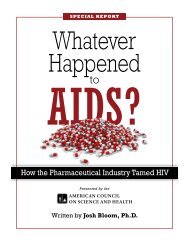The Role of Beef in the American Diet - International Meat Secretariat
The Role of Beef in the American Diet - International Meat Secretariat
The Role of Beef in the American Diet - International Meat Secretariat
You also want an ePaper? Increase the reach of your titles
YUMPU automatically turns print PDFs into web optimized ePapers that Google loves.
<strong>The</strong> <strong>Role</strong> <strong>of</strong> <strong>Beef</strong> <strong>in</strong> <strong>the</strong> <strong>American</strong> <strong>Diet</strong><br />
Thus, <strong>of</strong> <strong>the</strong> total fatty acids <strong>in</strong> beef, only about one-third are cholesterol-rais<strong>in</strong>g<br />
fatty acids.<br />
Figure 3. Fatty acids <strong>in</strong> beef <strong>in</strong>clud<strong>in</strong>g stearic acid<br />
16<br />
Recently, concerns have been raised about levels <strong>of</strong> trans fatty acids<br />
<strong>in</strong> <strong>the</strong> diet. Trans fatty acids are unsaturated but, because <strong>of</strong> <strong>the</strong>ir unusual<br />
chemical configuration, <strong>the</strong>y raise levels <strong>of</strong> undesirable low-density<br />
lipoprote<strong>in</strong> (LDL) cholesterol and lower levels <strong>of</strong> desirable high-density<br />
lipoprote<strong>in</strong> (HDL) cholesterol. <strong>The</strong> National Academy <strong>of</strong> Sciences<br />
(NAS) recently recommended that consumption <strong>of</strong> <strong>the</strong>se fatty acids<br />
should be kept as low as possible with<strong>in</strong> <strong>the</strong> context <strong>of</strong> a nutritionally<br />
adequate diet (31) because <strong>the</strong>y have an undesirable effect on cholesterol<br />
levels and no nutritional benefit. However, <strong>the</strong> NAS noted that<br />
completely elim<strong>in</strong>at<strong>in</strong>g trans fatty acids from a typical person’s diet<br />
would make it very difficult to meet o<strong>the</strong>r nutritional guidel<strong>in</strong>es.<br />
<strong>The</strong> pr<strong>in</strong>cipal source <strong>of</strong> trans fatty acids <strong>in</strong> <strong>the</strong> U.S. diet is hydrogenated<br />
vegetable fats such as margar<strong>in</strong>e, shorten<strong>in</strong>g, and foods that<br />
conta<strong>in</strong> <strong>the</strong>m. <strong>The</strong> trans fatty acids are produced dur<strong>in</strong>g <strong>the</strong> hydrogenation<br />
process that transforms liquid oils <strong>in</strong>to solid fats. Trans fatty acids<br />
are also produced naturally by rum<strong>in</strong>ant animals and <strong>the</strong>refore are present<br />
<strong>in</strong> foods derived from those animals, <strong>in</strong>clud<strong>in</strong>g beef, lamb, and dairy<br />
products. However, unlike <strong>the</strong> trans fatty acids <strong>in</strong> hydrogenated vegetable<br />
fats, those <strong>in</strong> foods <strong>of</strong> animal orig<strong>in</strong> are <strong>of</strong> little concern for two<br />
reasons:<br />
1. As shown <strong>in</strong> Table 4, <strong>the</strong> amount <strong>of</strong> trans fatty acids <strong>in</strong> beef and<br />
o<strong>the</strong>r animal products is small <strong>in</strong> comparison with <strong>the</strong> amount <strong>in</strong><br />
foods made with hydrogenated vegetable fats.










